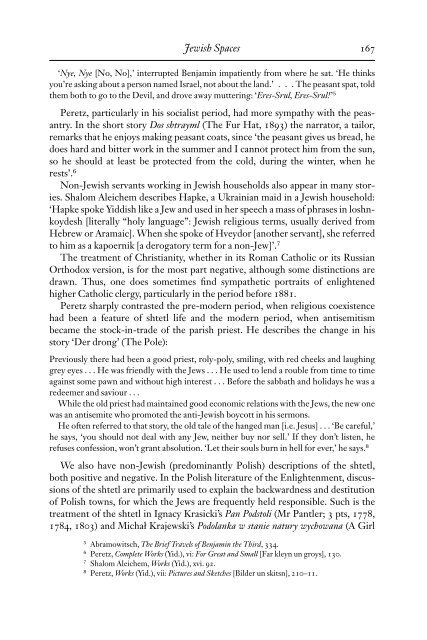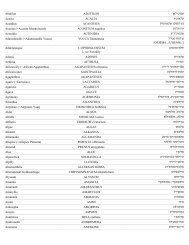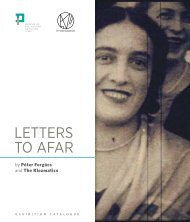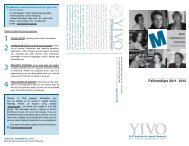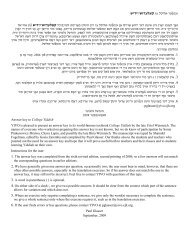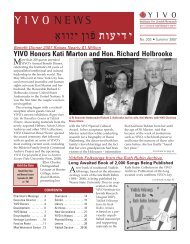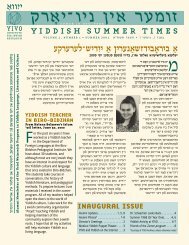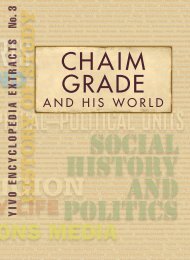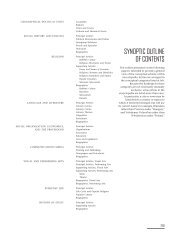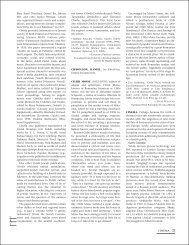Read - YIVO Institute for Jewish Research
Read - YIVO Institute for Jewish Research
Read - YIVO Institute for Jewish Research
Create successful ePaper yourself
Turn your PDF publications into a flip-book with our unique Google optimized e-Paper software.
<strong>Jewish</strong> Spaces 167‘Nye, Nye [No, No],’ interrupted Benjamin impatiently from where he sat. ‘He thinksyou’re asking about a person named Israel, not about the land.’ . . . The peasant spat, toldthem both to go to the Devil, and drove away muttering: ‘Eres-Srul, Eres-Srul!’ 5Peretz, particularly in his socialist period, had more sympathy with the peasantry.In the short story Dos shtrayml (The Fur Hat, 1893) the narrator, a tailor,remarks that he enjoys making peasant coats, since ‘the peasant gives us bread, hedoes hard and bitter work in the summer and I cannot protect him from the sun,so he should at least be protected from the cold, during the winter, when herests’. 6Non-<strong>Jewish</strong> servants working in <strong>Jewish</strong> households also appear in many stories.Shalom Aleichem describes Hapke, a Ukrainian maid in a <strong>Jewish</strong> household:‘Hapke spoke Yiddish like a Jew and used in her speech a mass of phrases in loshnkoydesh[literally “holy language”: <strong>Jewish</strong> religious terms, usually derived fromHebrew or Aramaic]. When she spoke of Hveydor [another servant], she referredto him as a kapoernik [a derogatory term <strong>for</strong> a non-Jew]’. 7The treatment of Christianity, whether in its Roman Catholic or its RussianOrthodox version, is <strong>for</strong> the most part negative, although some distinctions aredrawn. Thus, one does sometimes find sympathetic portraits of enlightenedhigher Catholic clergy, particularly in the period be<strong>for</strong>e 1881.Peretz sharply contrasted the pre-modern period, when religious coexistencehad been a feature of shtetl life and the modern period, when antisemitismbecame the stock-in-trade of the parish priest. He describes the change in hisstory ‘Der drong’ (The Pole):Previously there had been a good priest, roly-poly, smiling, with red cheeks and laughinggrey eyes . . . He was friendly with the Jews . . . He used to lend a rouble from time to timeagainst some pawn and without high interest . . . Be<strong>for</strong>e the sabbath and holidays he was aredeemer and saviour . . .While the old priest had maintained good economic relations with the Jews, the new onewas an antisemite who promoted the anti-<strong>Jewish</strong> boycott in his sermons.He often referred to that story, the old tale of the hanged man [i.e. Jesus] . . . ‘Be careful,’he says, ‘you should not deal with any Jew, neither buy nor sell.’ If they don’t listen, herefuses confession, won’t grant absolution. ‘Let their souls burn in hell <strong>for</strong> ever,’ he says. 8We also have non-<strong>Jewish</strong> (predominantly Polish) descriptions of the shtetl,both positive and negative. In the Polish literature of the Enlightenment, discussionsof the shtetl are primarily used to explain the backwardness and destitutionof Polish towns, <strong>for</strong> which the Jews are frequently held responsible. Such is thetreatment of the shtetl in Ignacy Krasicki’s Pan Podstoli (Mr Pantler; 3 pts, 1778,1784, 1803) and Micha≥ Krajewski’s Podolanka w stanie natury wychowana (A Girl5Abramowitsch, The Brief Travels of Benjamin the Third, 334.6Peretz, Complete Works (Yid.), vi: For Great and Small [Far kleyn un groys], 130.7Shalom Aleichem, Works (Yid.), xvi. 92.8Peretz, Works (Yid.), vii: Pictures and Sketches [Bilder un skitsn], 210–11.


